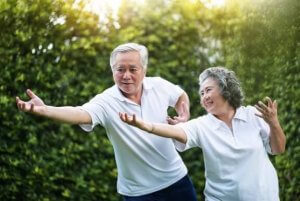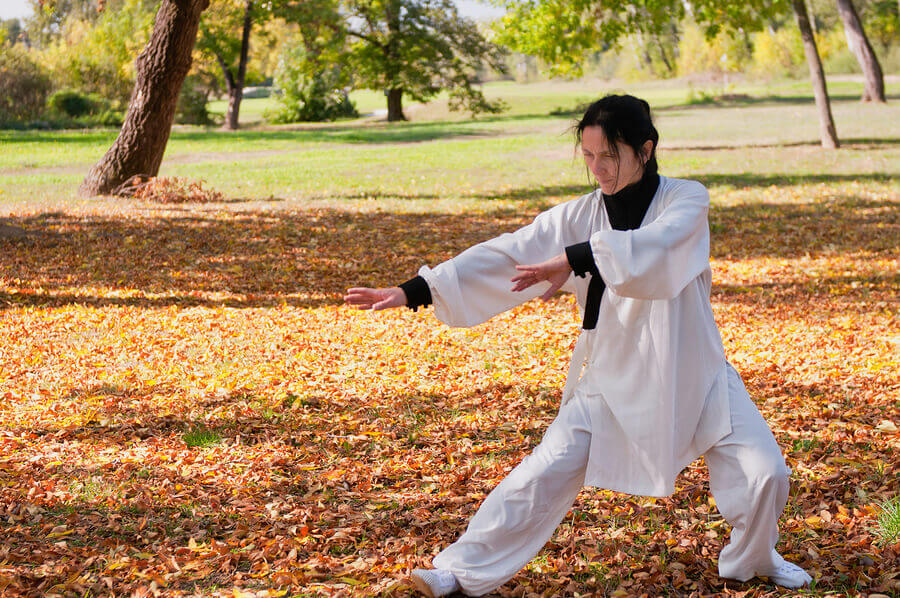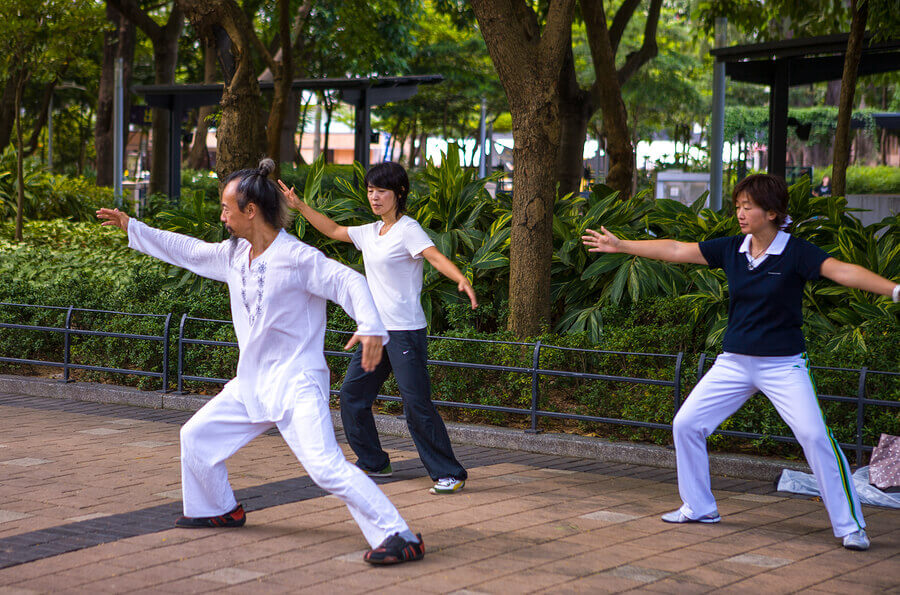Why Is Tai Chi Used to Improve Balance?

Tai chi is a martial art that’s based on slow, fluid and precise movements. One of its many benefits is that it helps to improve balance. This article will tell you all you need to know about tai chi.
Tai chi provides a series of movements and exercises in order to work the body and calm the mind. In terms of physical benefits, tai chi helps the body maintain strength, flexibility, and a range of motions and reflexes.
Tai chi is especially useful when it comes to improving balance and preventing falls. A fall, of course, is the main concern when it comes to older people. As with other disciplines such as yoga, tai chi is also meditative and it can offer relaxation.
These physiological changes help to lower blood pressure, heart rate, respiratory rate, oxygen consumption, adrenaline levels and levels of cortisol, the hormone that regulates stress.
Tai chi is ideal for improving balance
Tai chi is often recommended daily in order to improve balance and reduce the risk of falls. Along with tai chi, yoga is another discipline that has well-known benefits in this regard.
There are several reasons why tai chi is considered to be useful when it comes to improving balance. Tai chi is believed to influence postural stability, flexibility, and strength.

In addition, tai chi is considered to be safe for everyone. It has been shown to have a positive impact on a person’s integral physical condition. While it’s possible to learn tai chi from books or videos, it’s best to work with an instructor in order to ensure that all of the movements are being performed correctly.
Keep in mind that people with health concerns and pregnant women should consult their doctors before practicing tai chi.
Tai chi is a discipline that can be adapted for all ages. It’s a safe form of exercise for older people with chronic diseases too. The activities performed are low impact and the intensity can be increased gradually.
Reducing the risk of falls in older people
Practicing tai chi regularly is great for the elderly. The exercises performed include a set of continuous, circular movements that are executed slowly and precisely in a pre-established order.
One of the advantages of this discipline is its adaptability to all ages and fitness levels. Tai chi is very low impact, it does not exert too much stress on the bones and joints. As if that was not enough, it’s also incredibly safe, even for the elderly and chronically ill.
Another positive aspect is that it reduces the risk of falls since it helps to improve balance and postural regulation. As a result, older people who practice tai chi regularly are less likely to suffer from fractures.
Tai chi has long been used in traditional Chinese medicine as a technique to work both the body and mind.

More demanding than thought
Tai chi is more of an aerobic exercise than people may believe. Other advantages of this discipline is that it helps to exercise the heart, effectively preventing heart disease.
If you observe the smooth and elegant movements of this ancient Chinese practice, it’s difficult to believe that it can burn a single calorie or strengthen muscles. However, tai chi includes exercises that are more dynamic than they seem.
As you can see, tai chi has long been used in traditional Chinese medicine as a technique to work both the body and mind through the performance of slow and gentle movements.
In any case, we are convinced that once you try a tai chi class, you’ll see how the combination of slow and precise movements combine to make an invigorating workout. Go ahead, and give this famous oriental discipline a chance.
Tai chi is a martial art that’s based on slow, fluid and precise movements. One of its many benefits is that it helps to improve balance. This article will tell you all you need to know about tai chi.
Tai chi provides a series of movements and exercises in order to work the body and calm the mind. In terms of physical benefits, tai chi helps the body maintain strength, flexibility, and a range of motions and reflexes.
Tai chi is especially useful when it comes to improving balance and preventing falls. A fall, of course, is the main concern when it comes to older people. As with other disciplines such as yoga, tai chi is also meditative and it can offer relaxation.
These physiological changes help to lower blood pressure, heart rate, respiratory rate, oxygen consumption, adrenaline levels and levels of cortisol, the hormone that regulates stress.
Tai chi is ideal for improving balance
Tai chi is often recommended daily in order to improve balance and reduce the risk of falls. Along with tai chi, yoga is another discipline that has well-known benefits in this regard.
There are several reasons why tai chi is considered to be useful when it comes to improving balance. Tai chi is believed to influence postural stability, flexibility, and strength.

In addition, tai chi is considered to be safe for everyone. It has been shown to have a positive impact on a person’s integral physical condition. While it’s possible to learn tai chi from books or videos, it’s best to work with an instructor in order to ensure that all of the movements are being performed correctly.
Keep in mind that people with health concerns and pregnant women should consult their doctors before practicing tai chi.
Tai chi is a discipline that can be adapted for all ages. It’s a safe form of exercise for older people with chronic diseases too. The activities performed are low impact and the intensity can be increased gradually.
Reducing the risk of falls in older people
Practicing tai chi regularly is great for the elderly. The exercises performed include a set of continuous, circular movements that are executed slowly and precisely in a pre-established order.
One of the advantages of this discipline is its adaptability to all ages and fitness levels. Tai chi is very low impact, it does not exert too much stress on the bones and joints. As if that was not enough, it’s also incredibly safe, even for the elderly and chronically ill.
Another positive aspect is that it reduces the risk of falls since it helps to improve balance and postural regulation. As a result, older people who practice tai chi regularly are less likely to suffer from fractures.
Tai chi has long been used in traditional Chinese medicine as a technique to work both the body and mind.

More demanding than thought
Tai chi is more of an aerobic exercise than people may believe. Other advantages of this discipline is that it helps to exercise the heart, effectively preventing heart disease.
If you observe the smooth and elegant movements of this ancient Chinese practice, it’s difficult to believe that it can burn a single calorie or strengthen muscles. However, tai chi includes exercises that are more dynamic than they seem.
As you can see, tai chi has long been used in traditional Chinese medicine as a technique to work both the body and mind through the performance of slow and gentle movements.
In any case, we are convinced that once you try a tai chi class, you’ll see how the combination of slow and precise movements combine to make an invigorating workout. Go ahead, and give this famous oriental discipline a chance.
All cited sources were thoroughly reviewed by our team to ensure their quality, reliability, currency, and validity. The bibliography of this article was considered reliable and of academic or scientific accuracy.
- Field, T. (2011). Tai Chi research review. Complementary Therapies in Clinical Practice, 17(3), 141–146. https://doi.org/10.1016/j.ctcp.2010.10.002
- McGinnis, P. Q. (2008). Tai Chi. In Complementary Therapies for Physical Therapy(pp. 139–155). Elsevier Inc. https://doi.org/10.1016/B978-072160111-3.50015-4
- Serrano, B. V., Moralesa, P. F., Martínez, F. G., Belmara, J. de L., & Rodríguez, J. L. Q. (2010). La práctica del Tai Chi previene las caídas en el anciano institucionalizado: un ensayo clínico. Revista Clínica de …, 3(1), 34–38. Retrieved from http://scielo.isciii.es/scielo.php?pid=S1699-695X2010000100008&script=sci_arttext%5Cnhttp://scielo.isciii.es/pdf/albacete/v3n1/original6.pdf
This text is provided for informational purposes only and does not replace consultation with a professional. If in doubt, consult your specialist.








